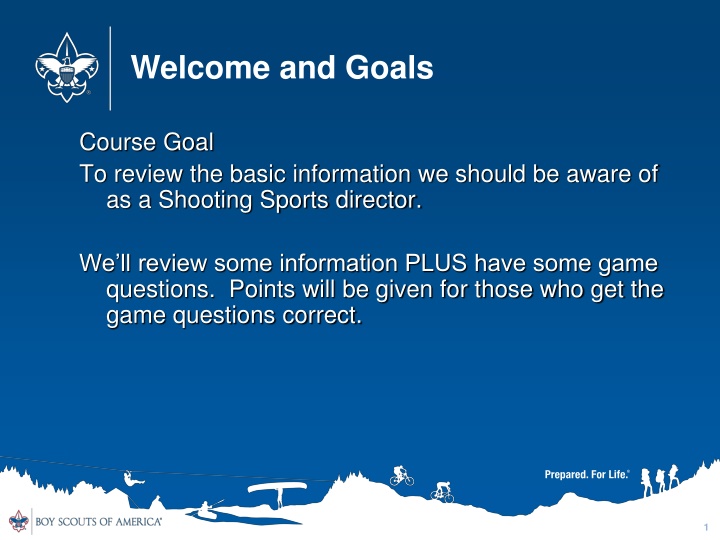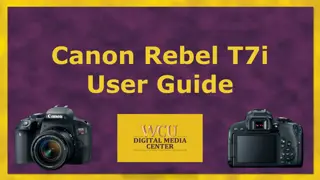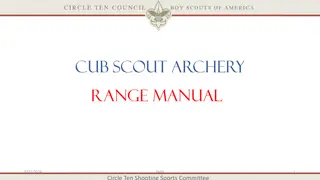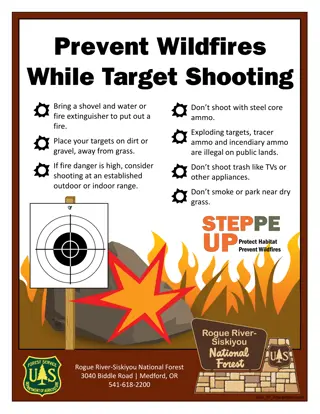Shooting Sports Director Essentials
Engage in a course covering key information needed as a Shooting Sports director, including the 5 levels of shooting sports, progression, topics at each level, programs supported by BSA, specialty activities, and the role of a Range Safety Officer.
Download Presentation

Please find below an Image/Link to download the presentation.
The content on the website is provided AS IS for your information and personal use only. It may not be sold, licensed, or shared on other websites without obtaining consent from the author.If you encounter any issues during the download, it is possible that the publisher has removed the file from their server.
You are allowed to download the files provided on this website for personal or commercial use, subject to the condition that they are used lawfully. All files are the property of their respective owners.
The content on the website is provided AS IS for your information and personal use only. It may not be sold, licensed, or shared on other websites without obtaining consent from the author.
E N D
Presentation Transcript
Welcome and Goals Course Goal To review the basic information we should be aware of as a Shooting Sports director. We ll review some information PLUS have some game questions. Points will be given for those who get the game questions correct. 1
What is the purpose of the 5 levels of shooting sports? To provide a planning guide to conduct safe shooting activities. They cover rifle, shotgun, pistol, and muzzleloading. For each discipline they provide the necessary topics to be covered at each level. 3
In general, how do the 5 levels progress? 1. A first-time shooting experience 2. An open shooting experience 3. Ongoing shooting experience (merit badge) 4. Competitive shooting 5. Become an instructor 4
GAM E QU ESTION #1 Name 5 of the 11 topics covered for each of the 5 levels. 1. Purpose 2. Examples 3. Participants 4. Firearm description 5. Ammunition 6. Range 7. Training 8. Safety 9. Range supervision 10. Ratio 11. Course 5
Where can I find the 5 steps? The National Shooting Sports Manual <BSA Home Outdoor Program Shooting Sports> 6
GAM E QU ESTION #2 Name two of the three programs that BSA has additional support for in terms of open and instructional shoots. 1. Rifle 2. Shotgun 3. Archery These can be found at: <BSA Home Outdoor Program Shooting Sports Scouts BSA Shooting Sports> 7
GAM E QU ESTION #3 Name three of the specialty shooting sports activities? 1. Chalkball 2. Multi-Gun Airsoft 3. Cowboy Action 4. BSA Scouts Pistol Safety & Marksmanship Program These can be found at: <BSA Home Outdoor Program Shooting Sports Scouts BSA Shooting Sports> 8
What is the role of an Range Safety Officer (RSO)? 1. Primary purpose to provide direct supervision of the firing line to ensure shooters follow range regulations (SOP). 2. The RSO s responsibility is to maintain order on the range. 9
GAM E QU ESTION #4 Name 3 of the 5 items a good SOP contains? 1. Organizational Information 2. Range Capabilities 3. Range Operations 4. Shooting Range Rules and Regulations 5. Emergency Response Plans 10
GAM E QU ESTION #5 Name three items you would pick up when checking in at the office to open a range. 1. SOP for range 2. First-aid kit 3. Communications equipment (including backup) 4. Keys, etc. 5. Range flags 6. Other 11
Range Inspections 1. The facility SOP should include inspection procedures. 2. Ensure that each item is checked. 3. EACH RANGE IS UNIQUE. 4. Check the SOP for the specific range. 5. Use your own GOOD JUDGEMENT! 12
GAM E QU ESTION #6 Name four items you would inspect upon arriving at an outdoor range. 1. Condition of range on arrival: clean/dirty? 2. Impact area functional? 3. Range area clear of personnel? 4. Target holders/throwers working properly? 5. Targets ready? 6. Communication and backup system working? 7. Safety briefing prepared? 8. Emergency procedures reviewed and checked? 9. Baffles and berms checked? 13
Categories of Shooting Range Rules NRA Gun Safety Rules o 3 Fundamental Rules for Safe Gun Handling o 8 Rules for Using or Storing a Gun General Range Rules Site-Specific Range Rules. Administrative Rules 14
GAM E QU ESTION #7 Name 5 of the 8 Rules for Using or Storing a Gun 1. Know your target and what is beyond. 2. Be sure the gun is safe to operate. 3. Know how to use the gun safely. 4. Use only the correct ammunition for your gun. 5. Never use alcohol or drugs before or while shooting. 6. Store guns so they are not accessible to unauthorized persons. 7. Wear eye and ear protection as appropriate. 8. Be aware that certain types of guns and many shooting activities require additional safety precautions. 15
Range Safety Briefing WHAT is the purpose of the range safety briefing? Prepares shooters to safely and efficiently participate in the shooting event. WHEN should the briefing be conducted? Prior to participants first use of the shooting range and before participating in a new or more advanced type of shooting event. WHERE should the briefing be conducted? At the range so users can view the range, key areas, equipment, etc. 16
GAM E QU ESTION #8 Name 3 of the 5 topics which should be included in a Standard Range Safety Briefing. 1. Purpose of the Shooting Event. 2. Range Layout and Limits. 3. Range Safety Rules. 4. Firing Line Commands. 5. Emergency Procedures. 17
EMERGENCY PROCEDURES Standardize steps and the sequence in which they are performed. 1. Take charge of the situation. 2. Call for help, if required. 3. Direct medical help to location. 4. Take notes (Reports). 18
GAM E QU ESTION #9 Name the five fundamentals of shooting a rifle. 1. Aiming 2. Breath Control 3. Hold Control 4. Trigger Control 5. Follow Through 19
GAM E QU ESTION #1 0 Which two of the five fundamentals are the most important? Aiming and Trigger Control 20
Rifle Shooting What are the NRA s eight steps to teach rifle shooting. 1. Study the position. 2. Assume the position without a rifle. 3. Assume the position with a rifle. 4. Align the position to the target. 5. Dry fire the rifle at the target. 6. Shoot at targets with live ammunition. 7. Adjust sights. 8. Continue firing. 21
GAM E QU ESTION #1 1 Name the five fundamentals of shooting a shotgun. 1. Stance 2. Gun Ready Position 3. Swing to Target 4. Trigger Pull 5. Follow Through 22
Shotgun Shooting What are the NRA s eight steps to teach shotgun shooting. 1. Determine Eye Dominance. 2. Watch straightaway targets. 3. Point finger at target. 4. Point finger and say Bang on touching target. 5. Review the five fundamentals. 6. Dry point shotgun at target. 7. Dry fire shotgun at target. 8. Shoot at target with live ammunition. 23























